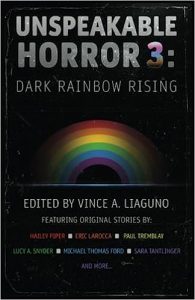
Victor A. Liaguno (ed.)
Crystal Lake Publishing (June 21, 2023)
Reviewed by Elaine Pascale
Don’t let the rainbow fool you—it is a dark one. The rainbow is a reminder of highs and lows, of starting points and of falling back. For many in this country, the arc of the rainbow represents the shaky ground that leaves for little balance due to quickly changing laws in a political climate that lacks shame in its own bigotry. Unspeakable Horror 3 is an anthology of queer horror that showcases the terrorizing vulnerability faced by members of the LGBTQIA community while the government toys with their rights.
I love reading anthologies as I benefit from being introduced to new, exciting writers. Unspeakable Horror 3 was no exception; while I enjoyed the stories written by recognizable names, my favorites were offerings from authors I had never read before.
Two stories drew me in with their hooks. First was “Such a Lovely Place,” by Mathew L. Reyes, that begins: “Mine isn’t the sort of family that commits murder.” The narrator might rethink that stance after moving into an HOA. The “Karen”-types in the story are recognizable and add to the unsettling ambiance. The second was “Border Towns,” by James Cato with: “Today, like on most weekdays, a man named Gael stalks me home on the train.” The story is not only about stalking, but also about art, inspiration, and obsession. This is weird horror at its finest.
Trauma is a common theme in Unspeakable Horror 3, most notably in “Immaculate,” by Maryse Meijer where Amie (he) runs a death metal fan page. The aggressive lyrics help Amie to deal with his psychological demons. And “Dinosaur on the 18th Hole,” by Kaitlin Tremblay provides an accurate depiction of vulnerability after a violation. The story is fraught with tension despite its whimsical backdrop of mini golf.
Sexual awakening is another important theme. In A. P. Thayer’s “Un Lamento de Flores,” the narrator falls in love with the beautiful Alejandra who is meant to serve as a maid/assistant while she is pregnant. This is no monster-under-the-bed horror; this is the very real distress of having a love within reach that you are not allowed to experience. “Daughters of Eve,” by Holly Lyn Walrath, is a lyrical extended metaphor about sexual awakening. And “Wishbone,” by Michael Thomas Ford took me back to the unfortunate era when Rock Hudson was not only the most famous victim of AIDS, but the misinformation around his condition exemplified the confusion about its transmission. The dialogue in the story rings true as does the sexual confusion of the main character.
In Oliver Nash’s “Queen of Dirt’s End,” Dirt’s End is the name of a bar where we are introduced to Euchre (they/them). We learn of a comet that is followed by some very cool body horror/creature feature synthesis.
My favorite story was “White Meat,” by Lucy A. Snyder. Julia is forced to return home for Thanksgiving—an idea that can be triggering for many even if they aren’t non-binary like Julia. Snyder deftly weaves the plot point of being trapped by murderers with being trapped in a body that doesn’t feel like yours.
Unspeakable Horror 3 is an impressive collection of 25 stories and one poem. As such, there are bound to be favorites along with offerings that are less memorable. One reason that some of the stories did not merit a mention is that they simply trailed off without a satisfying conclusion. While I understand that that style may represent the indeterminate nature of queer life in America, I do prefer a more substantial ending. I admire that Unspeakable Horror 3 is not heavy-handed with political statements. The stories allow readers to feel the injustice organically. Due to the variety of offerings, there is something in Unspeakable Horror 3 for everyone.








